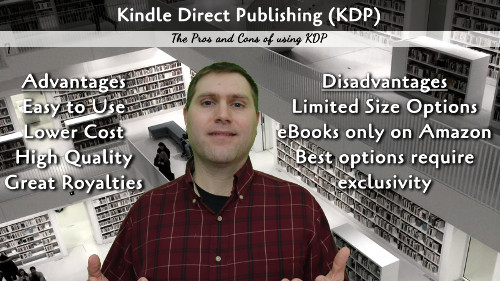KDP, or Kindle Direct Publishing, is an easy-to-use platform free to use for authors and publishers that will get your Print and eBooks onto Amazon.
The KDP platform is very user-friendly for uploading your books for publication. Of course, you need to have files ready to go. The preferred final book files are PDF and the eBook files are ePUB. If you have written your manuscript and need to convert your book into the correct format, you can learn to do the task using the information on this site, or you can just hire someone! If you like my content, you can hire me! Just email me from my contact form and I will get back to you. Once you have the final files, you can head over and start uploading content. We will not detail how to use the service in this article; that tutorial will be coming soon. Presently, we will look at the reasons KDP should be used by authors and publishers.
KDP Advantages
The biggest advantages to KDP is a higher royalty for Amazon properties. While IngramSpark only offers up to 55% royalty, KDP offers up to 60% on print books and 70% on eBooks! Also, it is free to set up your book title. Outside the fees and royalties, the platform supports most book print sizes, and they have the widest reach for all books. The behind the scenes allow you to control your books keywords and categories with relative ease and there is also a build in advertising system you can use to market your books directly on Amazon properties or Kindle devices.
Behind the scenes, it is very easy to update your book prices and those changes go into effect within a few hours at most. The sales reports are easy to read and configure making your job of tracking sales pretty easy and customizable.
KDP Disadvantages
The KDP platform does come with some disadvantages you need to be aware of. Firstly, they do try to upsell exclusivity for eBooks with higher royalties on lower listing prices and free giveaway weekends, but this means you cannot list your book on any other platform, including your own personal site. Also, you can not give it away during the 90-day exclusive period. This means you may lose some market share. Even if you do not want to go exclusive, Amazon does not like competition in the eBook market, so if you only list your book on KDP, it will only be available on Amazon and anywhere else you can put your eBook for sale.
For print books, the first of the disadvantages is that the book trim sizes are limited compared to other companies like IngramSpark. This means if you want your novel to be the standard paperback trim size, you will not be able to olist it on KDP directly, though IngramSpark can still put your book on Amazon. Additionally, if you want to list your print book in the Expanded Distribution to put your book in other bookstores, you will only receive a tiny 25% royalty on those sales. I get around this downside by listing books on both KDP and IngramSpark.


